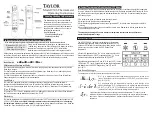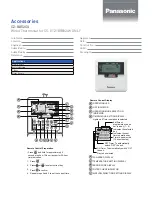
23
22
E SCAN symbol appears during measurement
F High temperature alarm
G Laser symbol
H Backlight on
I
Battery charge level indicator
J Mode
K Emission level display
L Function value
4.2 | Control buttons
7
8
1 Trigger
2 Laser beam ON/OFF
3 Temperature unit
4 Backlight
5 SET button
6 EMS button
7 Infrared sensor
8 Laser outlet
5 | Using the thermometer for the fi rst time
5.1 | Distance to spot size (D:S)
When taking a measurement, observe the correct distance to spot size. As the
distance from the target surface (D) increases, the spot size (S) of the area
measured by the device becomes larger.
The device has a distance-to-spot-size ratio of 12:1.
This device is equipped with a laser to make aiming easier.
Make sure that the target is larger than the device's spot size. The smaller the
target, the closer the measuring distance. If accuracy is important, make sure
that the target object is at least twice as big as the spot size.
5.2 | Emission level
Most organic materials and painted or oxidised surfaces have an emission level
of 0.95 (this value is preset on the device).
Measuring shiny or polished metal surfaces will produce imprecise readings.
To compensate for this, the emission level display on the device will need to
be adjusted or the surface being measured will need to be covered with dark
adhesive tape.
The temperatures of the adhesive tape and the surface being measured must
then be able to align. The surface which is covered with adhesive tape can now
be measured.
It is not possible to take measurements through transparent surfaces,
such as glass or plastic.
Material
Emission level
Aluminium
0.30
Asbestos
0.95
Asphalt
0.95
Basalt
0.70
Concrete
0.95
Copper
0.95
Soiling
0.94
Frozen food
0.90
Hot food
0.93
Glass
0.85
Ice
0.98
Iron
0.70
Lead
0.50
Limestone
0.98
Oil
0.94
Material
Emission level
Brass
0.50
Brick
0.90
Coal
0.85
China
0.95
Paint
0.93
Paper
0.95
Plastic
0.95
Rubber
0.95
Sand
0.90
Skin
0.98
Snow
0.90
Steel
0.80
Textiles
0.94
Water
0.93
Wood
0.94













































